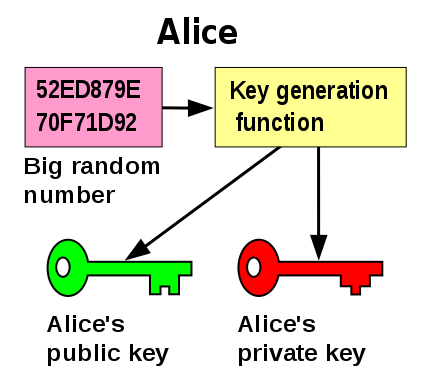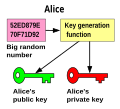Fitxer:Public key making.svg

Mida d'aquesta previsualització PNG del fitxer SVG: 426 × 384 píxels. Altres resolucions: 266 × 240 píxels | 533 × 480 píxels | 852 × 768 píxels | 1.136 × 1.024 píxels | 2.272 × 2.048 píxels.
Fitxer original (fitxer SVG, nominalment 426 × 384 píxels, mida del fitxer: 14 Ko)
Historial del fitxer
Cliqueu una data/hora per veure el fitxer tal com era aleshores.
| Data/hora | Miniatura | Dimensions | Usuari/a | Comentari | |
|---|---|---|---|---|---|
| actual | 04:26, 19 maig 2007 |  | 426 × 384 (14 Ko) | Davidgothberg | One more try, now using "Arial, Bold, 24" instead of "Arial Black, 22". |
| 04:22, 19 maig 2007 |  | 426 × 384 (13 Ko) | Davidgothberg | Trying with new font like Geni suggested. Now with the new terminology too. | |
| 03:44, 19 maig 2007 |  | 409 × 384 (15 Ko) | Geni | again | |
| 03:41, 19 maig 2007 |  | 409 × 384 (14 Ko) | Geni | attempt to fix 2 all this still PD | |
| 03:36, 19 maig 2007 |  | 409 × 384 (13 Ko) | Geni | trying to fix | |
| 03:08, 19 maig 2007 |  | 409 × 384 (13 Ko) | Davidgothberg | Reverted to earlier revision | |
| 03:06, 19 maig 2007 |  | 426 × 384 (10 Ko) | Davidgothberg | Argh! Previous image did not render right on Wikipedia. Trying new version saved in slightly different way... | |
| 03:02, 19 maig 2007 |  | 426 × 384 (13 Ko) | Davidgothberg | Slight change of terminology. User Birkett pointed it out and the Google test confirms it. "Key making function" -> "Key generation function" | |
| 20:43, 21 ago 2006 |  | 409 × 384 (13 Ko) | Davidgothberg | Slightly improved image. (Damn, this non-wysiwyg!) | |
| 20:39, 21 ago 2006 |  | 409 × 384 (13 Ko) | Davidgothberg | Slightly improved image. |
Ús del fitxer
La pàgina següent utilitza aquest fitxer:
Ús global del fitxer
Utilització d'aquest fitxer en altres wikis:
- Utilització a de.wikipedia.org
- Utilització a en.wikipedia.org
- Utilització a ur.wikipedia.org
🔥 Top keywords: PortadaEspecial:CercaJuraj CintulaPeretViquipèdia:ContacteManuel de Pedrolo i MolinaNova CaledòniaEspecial:Canvis recentsRobert FicoJessica Goicoechea JoverCarles Puigdemont i CasamajóEslovàquiaXavlegbmaofffassssitimiwoamndutroabcwapwaeiippohfffXOriol Junqueras i ViesMauricio WiesenthalEleccions al Parlament de Catalunya de 2024Cas Asunta BasterraClara Ponsatí i ObiolsJoan Salvat-PapasseitAntoni Comín i OliveresLluís Puig i GordiEsquerra Republicana de CatalunyaValtònycAamer AnwarBorratjaTor (Alins)Fermín López MarínLaia Flores i CostaSegona Guerra MundialLaura Borràs i CastanyerProvíncies de CatalunyaSílvia Orriols SerraJosep Costa i RossellóPresident de la Generalitat de CatalunyaParlament de CatalunyaAurora Madaula i GiménezHistòria del cristianismeComarques de CatalunyaRamón Cotarelo García



